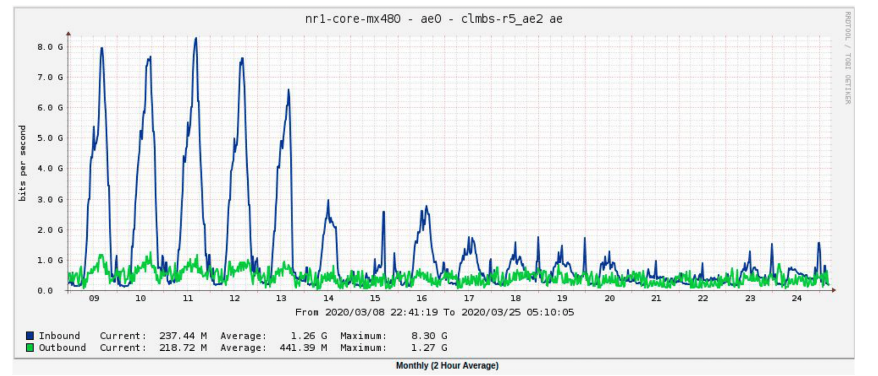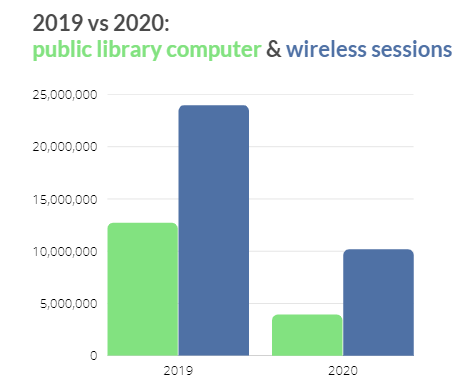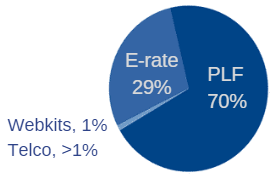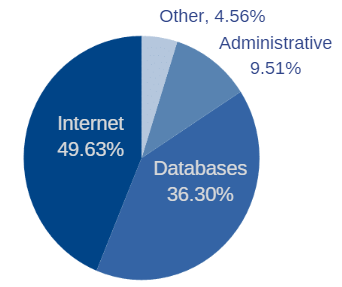July 1, 2019 - June 30, 2020 and July 1, 2020 - June 30, 2021
OPLIN Staff
Don Yarman, Director
Karl Jendretzky, Technology Project Manager
Laura Solomon, Library Services Manager
Jessica Dooley, Infrastructure Specialist
Vince Riley, Network Support
Board of Trustees
Angela Baldree, former Morley Library Trustee
Travis Bautz, MidPointe Library System
Jamie Black, former Loundonville Public Library Trustee
Justin Bumbico (Vice-Chair ‘21), Columbus Metropolitan Library
Chris May (Vice-Chair '20, Chair '21), Mansfield-Richland County Public Library
Travis McAfee (Chair '20), Wood County District Public Library
Roger Donaldson, Jackson City Library
Hilary Prisbylla, CLEVNET
Holly Richards, Dayton Metro Library
Tara Sidwell (Treasurer ‘20-’21), Kate Love Simpson-Morgan County Library
Garalynn Tomas (Secretary ‘20-’21), Lorain Public Library System Trustee
The current OPLIN Strategic Plan is online at oplin.ohio.gov/strategic-plan.
Services
Internet

OPLIN provides an Ethernet internet connection for Ohio public library systems and regional library systems, a total of 256 circuits. Circuit bandwidth is determined by usage, ranging in size from a minimum of 100 Mbps to 5 Gbps. All data traffic from the circuits is aggregated at the State of Ohio Computer Center before routing to the commodity internet. Before March 2020, daily bandwidth approached 9 Gbps at peak times.
How the pandemic shutdown affected daily library bandwidth utilization:

The majority of the demand for internet access comes from over 14,000 public computers and nearly 24 million wireless sessions in Ohio libraries, so when the COVID-19 pandemic forced libraries to close their buildings, bandwidth utilization fell below 1 Gbps. As libraries reopened, internet demand slowly grew. By June 2021, daily traffic was approaching 6 Gbps at peak utilization.
Research Databases

Most of the electronic resource titles OPLIN provides are cooperatively purchased in partnership with Libraries Connect Ohio (librariesconnectohio.org). This cost-effective arrangement provides all Ohioans with free access at ohioweblibrary.org to reference tools, newspaper and magazine articles, and continuous learning resources that many individual libraries could not afford. Additionally, OPLIN purchases statewide access to skills development video courses from LinkedInLearning, and to a premiere collection of genealogy resources.
Electronic resource vendors were generous during the pandemic, developing guides to help parents and educators with the difficulties of remote learning, making parts of their collections freely available on the internet, upgrading library content packages, and loosening usage restrictions. Ancestry.com, which was previously restricted to in-library use only, was made available to library patrons from their homes, and usage immediately increased 572%.
Database utilization increased sharply during the pandemic.
$0.40 cost per use

In 2019, Lynda.com's parent company LinkedIn announced that the content would be relaunched as LinkedIn Learning, and that library patrons would be required to create and use personal LinkedIn social media accounts to access the content. American libraries objected strongly, and LinkedIn changed directions. They delayed library migrations for a year, and made important changes to the LinkedIn Learning for Libraries product that preserves the privacy of library users. Ohio libraries migrated to the new platform the first week of May 2021.
Database Authentication

The migration to LinkedIn Learning for Libraries highlighted the need for a universally compatible authentication platform. OPLIN developed Mask, a secure authentication middleware for electronic resources. Mask accepts vendor authentication requests, passes the request to a library's ILS, and authenticates the patron to the vendor's platform over an encrypted connection. Mask is compatible with every ILS used by Ohio libraries. Libraries can use Mask as their authentication middleware with titles including Hoopla, Freegal, Kanopy, EZproxy, and more. Mask has authenticated over 75,000 library user sessions.
Webkits

Ohio public libraries have the option of purchasing a professionally built website with all maintenance, upgrades and hosting handled by OPLIN. Since Drupal 7 & 8 will reach end of life in November 2021, OPLIN performed extensive updates to ensure all webkits are running Drupal 9 before that date. From March 2019-August 2020, OPLIN worked with Braindunk, LLC, to create a new Webkit template for Drupal 8. By August 2020, 80 hosted websites were upgraded to Drupal 8. From March - May 2021, OPLIN staff upgraded all webkits to Drupal 9, with no downtime or impact to library users. Currently, 87 Ohio public libraries have an OPLIN webkit.
Financial Statement
Revenue
Since Fiscal Year 2012, OPLIN has received an annual transfer of $3,689,788 from the Ohio Public Library Fund (PLF). The other major source of revenue is annual reimbursement of a portion of internet costs distributed through the Schools and Libraries division of the federal universal service support program (E-rate). The OPLIN state budget includes $2 million in "spending authority" to permit the expenditure of these federal funds.
Expenditures
90% of OPLIN expenditures were for direct services to libraries.
Items in the "Other services" category include annual OpenDNS licenses for filtering the internet, used so far by 156 library systems; EZproxy, which supports remote access to databases; E-rate training and support; and the rent for space in the State of Ohio Computer Center, housing critical support systems and the Co-Location Service available to public libraries and library consortia.
OPLIN by the Numbers
Stats at-a-glance
| Service | Stat |
|---|---|
| Internet circuits for libraries | 256 |
| Daily peak bandwidth utilization | 7 GBPS |
| Website Kits | 87 |
| SMS notifications sent | 2.43 million |
| Listserv subscribers | 2,637 |
| Database item retrievals | 11.6 million |
| Serving Ohio public libraries | 25 years |
FY2020 Revenue & Expenditures
| Source | Amount |
|---|---|
| Public Library Fund | $3,689,788 |
| E-rate reimbursements | $1,923,579 |
| Website Kits | $53,793 |
| Telco refunds | $6,322 |
| TOTAL | $5,673,482 |
| Item | Amount |
|---|---|
| Internet | $2,480,000 |
| Databases | $2,428,713 |
| Administrative | $694,811 |
| Other services | $247,000 |
| TOTAL | $5,850,524 |
FY2021 Revenue & Expenditures
| Source | Amount |
|---|---|
| Public Library Fund | $3,689,788 |
| E-rate reimbursements | $2,052,953 |
| Website Kits | $59,310 |
| Telco refunds | $0 |
| TOTAL | $5,802,052 |
| Item | Amount |
|---|---|
| Internet | $3,121,258 |
| Databases | $2,282,835 |
| Administrative | $598,078 |
| Other services | $286,658 |
| TOTAL | $6,288,829 |
The Ohio Public Library Information Network (OPLIN) provides broadband internet connections and related information services to Ohio public libraries. Our vision is to ensure that all Ohio residents have fast, free public internet access through the 251 local public library systems in Ohio, as well as the use of high-quality statewide research databases.
OPLIN is defined in the Ohio Revised Code section 3375.64 as "an independent agency within the State Library of Ohio, for the purpose of ensuring equity of access to electronic information for all residents of this state." Planning for OPLIN started at the beginning of 1994 under the leadership of the Ohio Library Council (OLC) and it was established in the State Library budget in fiscal year 1996.
OPLIN collaborates with other state agencies, receiving extensive operational support from the State Library of Ohio and network management assistance from the Ohio Office of Information Technology (OIT).



